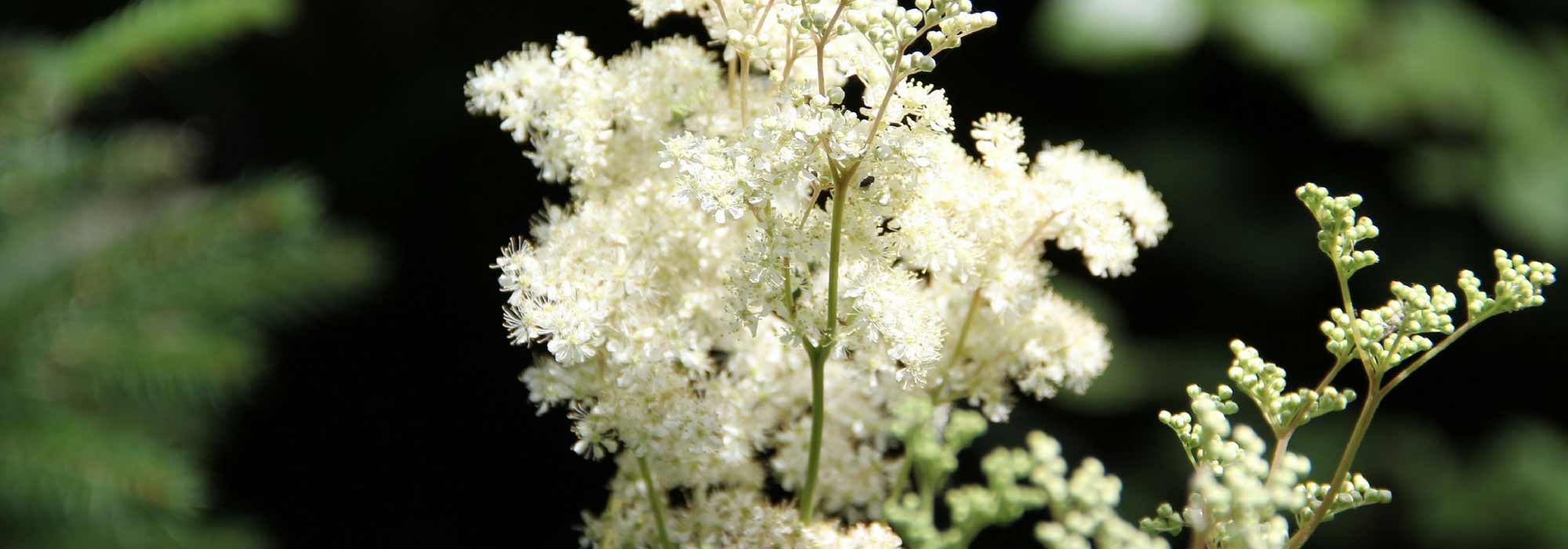
Filipendula, Meadow sweet: planting and caring
Contents
Filipendula in a nutshell
- Filipendula is the essential perennial for heavy, moist soil
- It produces an extraordinary, misty flowering in panicles of white or pink flowers
- Majestic and airy, some Filipendulas reach over 2 metres in height
- Very hardy, it can be grown in the coldest regions
- It is the emblematic perennial of pond edges, banks, and wild, moist borders
A word from our expert
The Filipendula, also known as Queen of the Meadows (Filipendula ulmaria) is a beautiful perennial for moist soil whose airy and melliferous summer flowering and attractive, finely cut foliage create a lovely combination of lushness and lightness, remarkable in a woodland setting.
Both wild and elegant, it suits all types of gardens as long as the soil remains moist in summer.
In the heart of summer, it offers an extraordinary flowering with airy plumes of white, red, or pink flowers that can reach nearly 2 m in height for some Filipendula.
While the white Filipendula is the most common, like Filipendula vulgaris, Filipendula rubra ‘Venusta’ and Filipendula purpurea ‘Elegans’ charm with their vibrant pink.
Easy to grow, never sick, this vigorous perennial with medicinal properties widely used in herbal tea requires just one thing: moisture.
The Filipendula thrives in sun or partial shade in all types of cool to moist soils, in wetland gardens, by the water’s edge, and in naturalistic borders and mixed borders that do not dry out. Full of nuances and lightness, requiring very little maintenance, it finds its place in naturalistic gardens, illuminating the slightest shaded corner with a unmatched brightness.
Quickly discover our collection of Filipendula, from new arrivals to our exclusives, and adopt this beautiful, easy-going perennial without delay, essential on the banks of a pond and in cool soils!
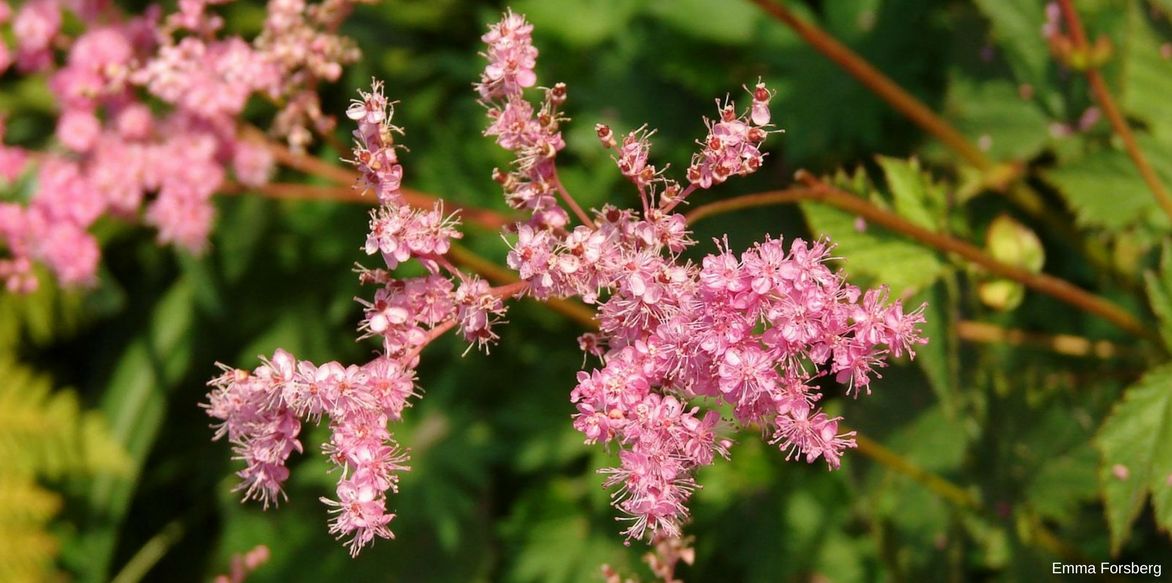
The pink inflorescences of Filipendula rubra.
Description and Botany
Botanical data
- Latin name Filipendula
- Family Rosaceae
- Common name Filipendula, queen of the meadows, meadow sweet
- Flowering June to August
- Height 0.30 to 1.50 m
- Exposure Sun, partial shade
- Soil type Neutral, acidic, well-drained
- Hardiness -15°C
Appartement à la très grande famille des rosacées, la Filipendula souvent appelée Reine des prés, est une hardy rhizomatous perennial, originating from riverbanks and wet meadows in North America. It has acclimatised throughout our regions, except in the north, where it naturally grows in ditches, by the watercourses, in meadows or wet forests.
The genus comprises about 10 species, including Filipendula ulmaria, which is available in numerous cultivars such as ‘Plena’ with double flowers and ‘variegata’ with variegated foliage, Filipendula palmata (palmate filipendula) with large palmate leaves, Filipendula purpurea (purple filipendula) with ‘Nana’, its dwarf form, the very hardy filipendula vulgaris (or Spiraea filipendula), Filipendula rubra or red filipendula, and the Filipendula camtschatica which reaches over 2 metres in height.
In spring, the Filipendula displays a clump habit of upright stems, sometimes slightly spreading and very bushy, more or less airy. Depending on the species, the height of the plants varies; some, like Filipendula rubra ‘Venusta’ and Filipendula palmata, form large structural bushes, potentially reaching 2 m high and 70 cm wide when in flower. Others are more modest and will not exceed 40 cm.
Once well-rooted, this rhizomatous perennial grows quickly to form over time powerful non-running clumps that can, however, become a bit invasive. They can also potentially produce spontaneous seedlings. It is a beautiful colonising plant to let naturalise in a woodland or by a pond. Filipendula ulmaria contributes to the greening of bank areas and their maintenance.
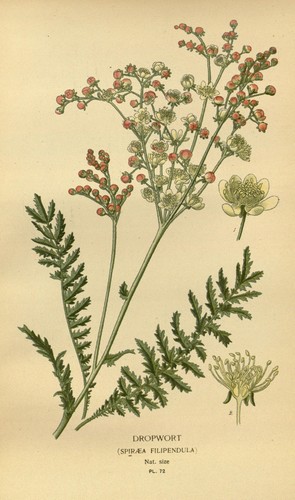
Filipendula vulgaris (= Spiraea filipendula) – botanical illustration.
From this rhizomatous clump emerge in spring multiple branching stems, sometimes slightly tinged with purple, quite rigid enough to stand without support. They bear large glossy leaves, pinnate, with a wrinkled surface, arranged alternately and borne on a long petiole.
Measuring 10 to 45 cm long, they divide into terminal leaflets cut into irregular lobes more or less deep and bear a few smaller lateral leaflets, glabrous or downy on the underside. This finely cut foliage is dentate like that of a fern in the case of common filipendula; in others, it resembles that of castor oil plants or some herbaceous peonies; it is neither lacking in elegance nor lightness. It consists of broad palmate leaves, deeply cut in Filipendula palmata, or palmate filipendula.
Their colour ranges from bright green to dark green. In Filipendula rubra, the young leaves are purple in spring. In ‘Variegata’, the green foliage is splashed with golden yellow at the centre of the leaf; in ‘Aurea’, it goes through many shades of light green and lemon green throughout the season. Filipendula ‘Red Umbrellas’ bears large green leaves marked with very graphic dark purple veins.
The Filipendula retains this beautiful deciduous foliage until the first frosts.
From May to September, the flowering in plumes of misty flowers rises above this large cut foliage. At the ends of the stiff stems, plume-like corymbs 2 to 25 cm in diameter made up of multiple small star-shaped flowers in white, yellowish white, red, pale pink, candy pink (‘Venusta’) or bright fuchsia pink (Filipendula purpurea), bloom in a colourful mist. From each flower emerge long protruding stamens that give the plant an increasingly airy appearance as they bloom.
This delicate flowering lasts for several weeks. The faded inflorescences dry to rusty brown tones and remain decorative for a long time once faded, even under frost.
They produce seeds that easily self-sow.
It emits a slight sweet almond fragrance that attracts pollinators, particularly butterflies.

Some cultivars with varied colours: Filipendula ulmaria, Filipendula palmata, Filipendula purpurea, Filipendula ‘Red Umbrellas’, Filipendula ulmaria ‘Plena’.
It is a low-maintenance plant, hardy down to -15 °C, that thrives in cool, shaded woodland environments. It is indispensable for clayey, heavy, wet soils.
Easy to cultivate once well established, it appreciates a rich, cool to moist soil, and both sunny and partial shade exposures.
It is ideal by ponds or a marsh, alongside other wetland plants, in a well-watered border or in a cool wild garden.
It also has purifying properties for the waters in which it grows. It is frequently used in phytoremediation systems to filter water bodies.
The Queen of the Meadows or Filipendula ulmaria is a plant that has been used for centuries in natural pharmacopoeia for its many virtues. Aromatic, it flavours herbal teas and medicinal drinks, while its flower buds contain analgesic, anti-inflammatory, diuretic, astringent, and tonic properties.

The foliage of filipendulas is very decorative: Filipendula purpurea ‘Alba’, Filipendula ulmaria ‘Variegata’, Filipendula vulgaris, Filipendula ulmaria ‘Aurea’, Filipendula ‘Red Umbrellas’.
Main species and varieties
The genus includes about ten species, including Filipendula ulmaria or meadowsweet, which is available in many interesting cultivars such as ‘Plena’ that has double flowers and ‘Variegata’ with variegated yellow-gold and green foliage.
The different species allow for varied heights (from 40 cm to nearly 2 m tall) and colours of the feathery corymbs (white, pink, or red).
Spectacular in size, Filipendula camtschatica can reach 2 m in height under good conditions, while Filipendula palmata ‘Nana’ will not exceed 40 cm in height at ripeness.

Filipendula ulmaria
- Flowering time July to September
- Height at maturity 1,20 m

Filipendula Kahome
- Flowering time July to September
- Height at maturity 40 cm

Filipendula palmata Nana
- Flowering time July to September
- Height at maturity 40 cm

Filipendula rubra Venusta
- Flowering time August, September
- Height at maturity 1,80 m

Filipendula ulmaria Variegata
- Flowering time July to September
- Height at maturity 60 cm

Filipendula ulmaria Plena
- Flowering time July to September
- Height at maturity 1 m

Filipendula camtschatica
- Flowering time August to October
- Height at maturity 2,50 m

Filipendula palmata
- Flowering time July to September
- Height at maturity 1 m

Filipendula purpurea Elegans
- Flowering time July to September
- Height at maturity 70 cm

Filipendula Red Umbrellas
- Flowering time July, August
- Height at maturity 70 cm
Discover other Filipendula
View all →Available in 0 sizes
Available in 0 sizes
Available in 0 sizes
Available in 0 sizes
Available in 3 sizes
Available in 0 sizes
Available in 0 sizes
Available in 1 sizes
Available in 2 sizes
Available in 1 sizes
Planting
Where to plant Filipendula?
Hardy down to -15°C, Filipendula can be found growing in various locations across France: its only requirement is a moist soil, it cannot tolerate a lack of water, nor dry soils. It will withstand summer heat in warmer regions, provided the soil remains consistently cool, but never waterlogged. A cool soil allows it to grow vigorously.
It thrives in wet areas in full sun if the soil stays cool or in partial shade in hot climates, under the protective cover of deciduous trees or bushes.
Tolerant, it adapts to ordinary soil, neutral to acidic, even heavy. However, it will be most abundant and reach its greatest height and flowering potential in rich, humus-bearing soil.
It truly flourishes at the edge of a damp woodland, on the banks of a pond or a marsh, where it will brighten the area with its luminous flowering. It is a good plant to allow to naturalise in a woodland setting. It is spectacular when planted in groups.
The tallest Filipendulas (Filipendula rubra, Filipendula camtschatica) will form large structural bushes at the back of borders. The smaller varieties (‘Kahome’, ‘Nana’) are ideal for small gardens and will add height to borders and beds.
When to plant Filipendula?
Plant Filipendula in spring from February to April, as soon as the risk of frost has passed, or in autumn from September to October, after the heat of summer has subsided.
How to plant Meadow sweet?
In open ground
Plant 3 to 5 plants per square metre, spaced at least 30 to 50 cm apart to allow for proper growth. For a beautiful effect at the edge of a pond, favour planting in small groups.
- Dig a hole 2 to 3 times wider than the root ball
- In poor soil, add well-rotted compost to the bottom of the hole
- Plant the root ball at collar level, it should be flush with the soil
- Bring the soil back to encase the roots and firm it down
- Water generously and then regularly in summer to aid establishment
- Keep the soil cool at the base with organic mulch during summer
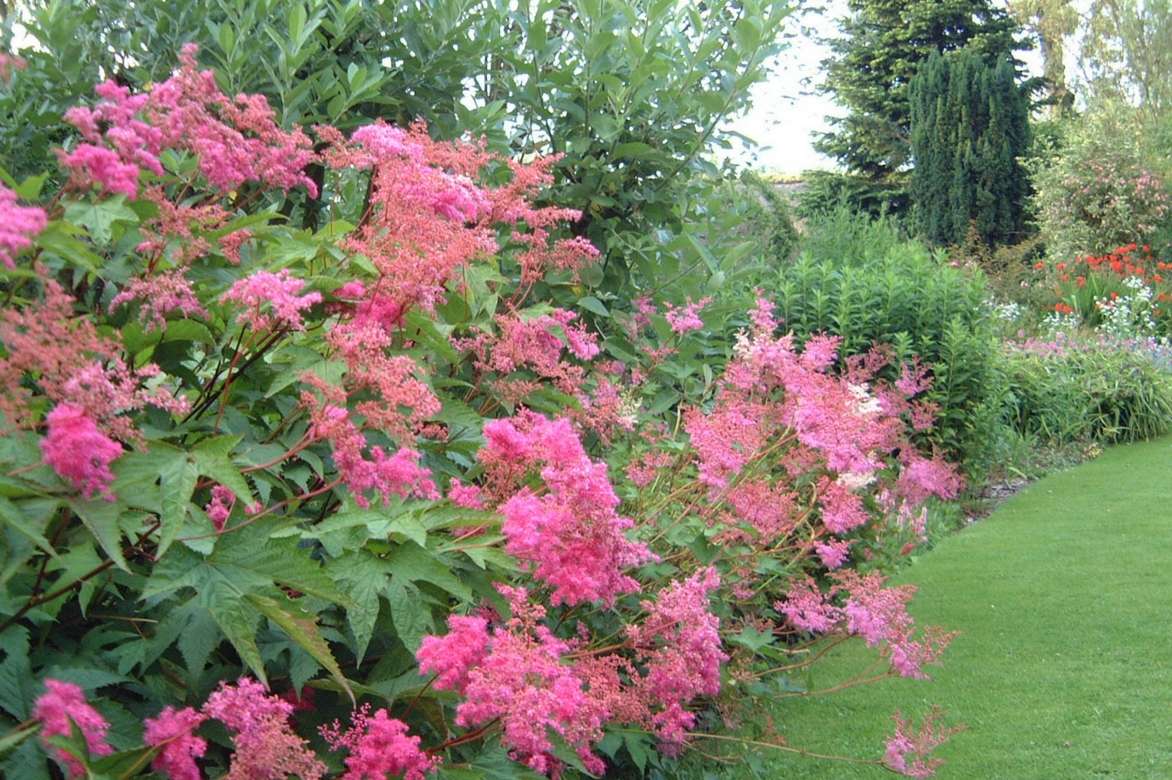
The beautiful Filipendula purpurea in situ.
Growing Filipendula in a pot
Choose a small variety with less growth (‘Nana’). Even more than in open ground, Filipendula will require a lot of water. Plant it in a large container, in a mix of potting soil and compost that is always moist. Spread a good layer of drainage (gravel or clay balls) at the bottom of the pot to improve drainage. Mulch and water very regularly, never allowing the substrate to dry out. Fertilise regularly with organic fertiliser during the flowering period.
Maintenance, pruning and care
The meadowsweet is a low-maintenance perennial as long as it does not lack water. It grows best in cool soil: during the first springs and summers, provide it with generous watering. During particularly dry summers, water daily but do not inundate it. If planted by a water feature, there is no need to water. Apply a good organic mulch around the base to limit evaporation.
In autumn, add one or two shovelfuls of compost at the base of the stump on the dormant rootstocks.
Regularly remove faded flowers at the base of the foliage to prolong the flowering, or leave them to dry on the plant to keep them throughout the winter.
At the end of winter or autumn, cut back the clumps to ground level. If your meadowsweet becomes invasive, limit the expansion of the clump by slicing the rootstocks.
Harvesting the flowers
Delicious and therapeutic in infusions, you can harvest the flowering tops of meadowsweet (Filipendula ulmaria) just as the flowers are beginning to open if you wish.
Dry them in the shade and out of direct sunlight. Then store them in a paper bag or jar.
→ To learn more, also read our tutorial: “ How to harvest and dry meadowsweet?“.
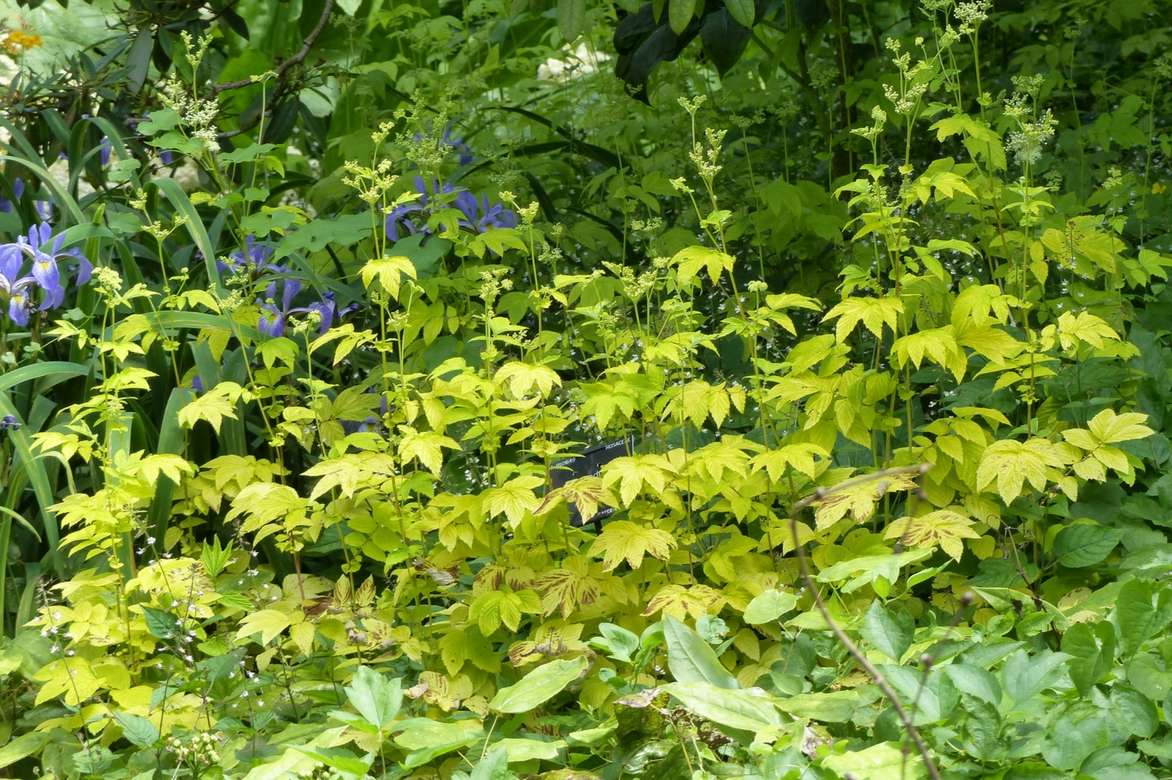
The golden foliage of Filipendula ulmaria ‘Aurea’ brightens up a shady corner of the garden.
Diseases and potential pests
Never sick, the Filipendula is a robust plant that is not subject to any disease or parasitic issues. It is the perfect perennial for beginner gardeners.
Propagating
The Filipendula multiplies very easily by clump division, after 3 to 5 years, when the plant is well established but the stump is not yet too difficult to handle.
- In March, use a spade to dig up some rootstocks with at least one eye before the leaves reappear
- Immediately replant these pieces in the garden in well-tilled, cool soil; the recovery is easy
Associating
The Filipendula, or Meadowsweet, is the essential aerial perennial to brighten up cool areas in a lush setting. Its elegant, feathery silhouette, its opulent deeply cut foliage, and its pastel pink, cream-white, or candy-pink inflorescences bring a lot of lightness near a pond, in a damp flowerbed, or in a cool border. It adds charm to soft, countryside-style gardens or prairie-style settings, providing breath, brightness, and colour.
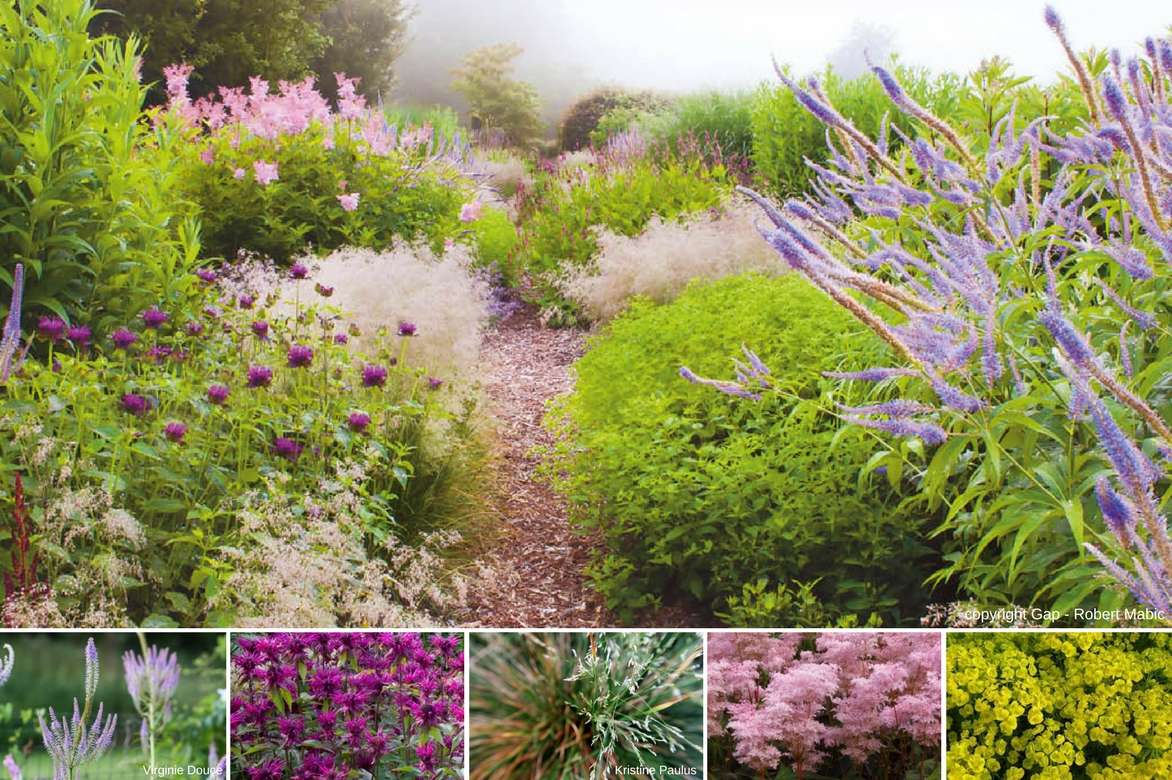
An example of a natural association: Monarda ‘Scorpion’, Deschampsia cespitosa, Veronicastrum virginicum ‘Fascination’, Euphorbia waldsteinii ‘Betten’, Filipendula palmata.
Whether it reaches nearly 2 m in height (Filipendula camtschatica or F. rubra ‘Venusta’) or is more modest in size (‘Nana’, F. vulgaris ‘Kahome’), it fits into all shaded and cool settings, and can play a dazzling role at the back of a border, creating a colourful mist, or serve as an airy flowering mass for the edges of a damp border alongside hardy geraniums, moisture-loving ground-covering polygonums, and Heucheras.
By the edges of a pond or bank, it will harmonise with perennials for wet banks, such as Japanese irises, beard-tongues, eupatoriums, Chinese loosestrife, butterbur, and knotweeds.
In a wild garden at the back of a border, its airy pink or white corymbs will happily blend with the mauve, lilac, lavender, violet, and other cool shades of Astilbes and willows.
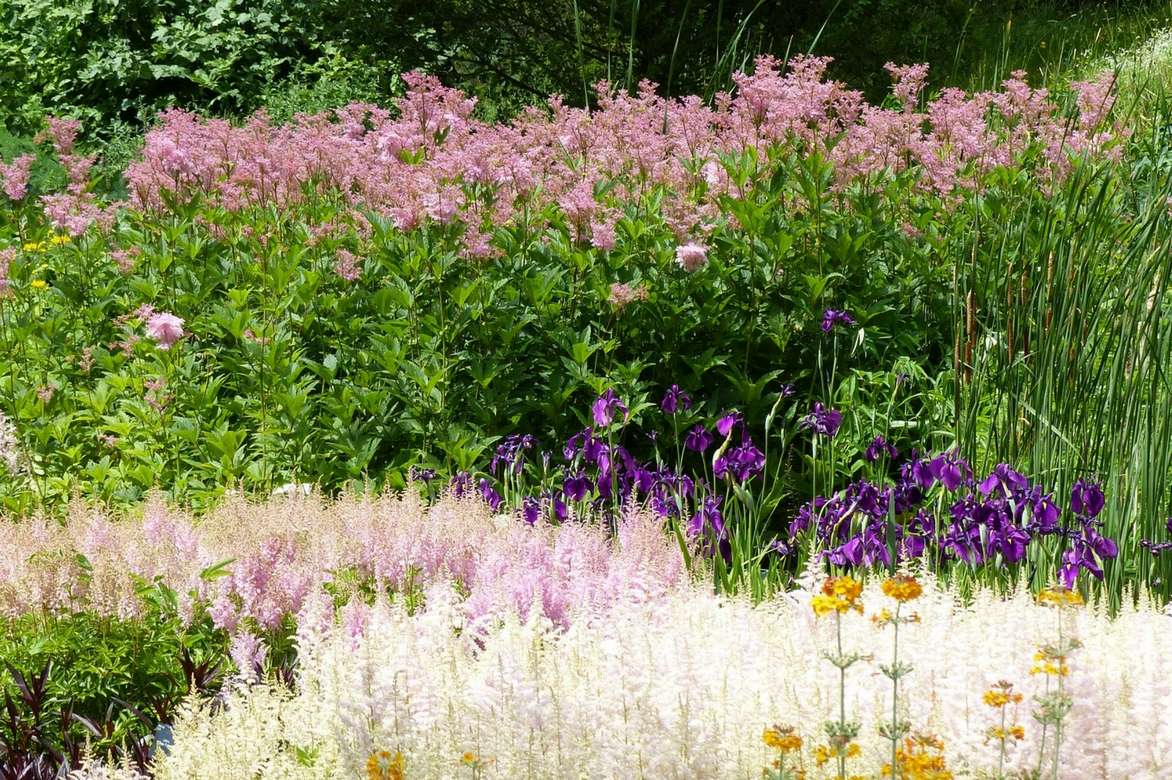
An idea for an association in always cool soil: Filipendula rubra ‘Venusta’, Iris hollandica ‘Blue Magic’, Astilbe simplicifolia ‘Pink Lightning’, Astilbe simplicifolia ‘Hennie Graafland’ and Primula bulleyana.
While it harmonises with the similar forms of astilbes, it contrasts with the more defined shapes of a Hosta Sun Power or with the graphic leaves of carex and ferns.
It easily associates with monardas and other perennials with generous foliage such as Acanthus mollis, or even Palmate rhubarb.
→ Discover 5 beautiful ideas for associating Filipendulas
Useful resources
- From the most classic to the exclusive, discover all our Filipendulas
- Our advice sheets: Filipendulas with white flowers: 6 varieties to discover, and Filipendulas with pink flowers: 6 varieties to discover
- Find our article: “Meadowsweet: a beautiful and useful medicinal plant” to learn more about meadowsweet infusion.
- Discover the comfort plants in our advice sheet
- Our advice sheet: Choosing a Filipendula or Meadowsweet
- Subscribe!
- Contents
































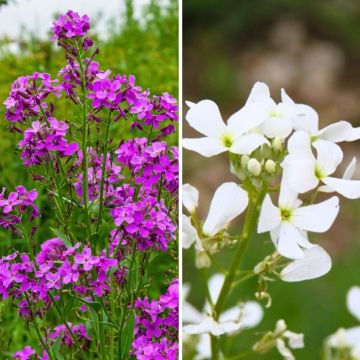
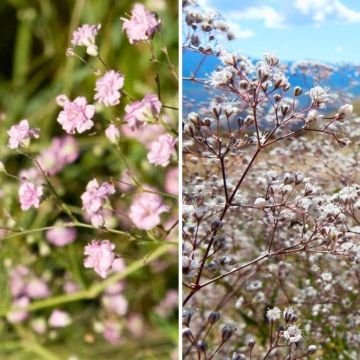
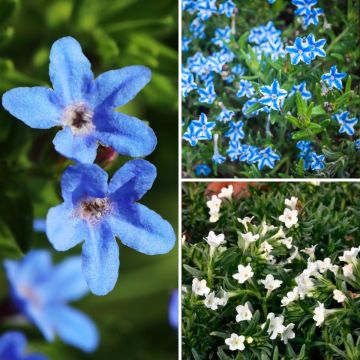
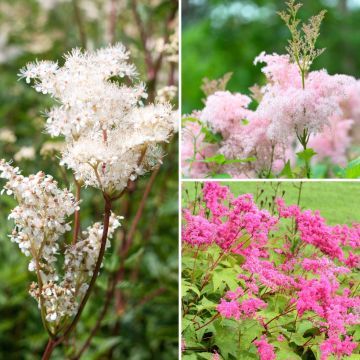
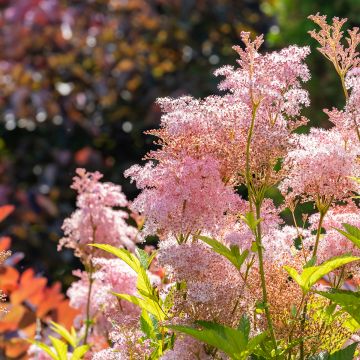
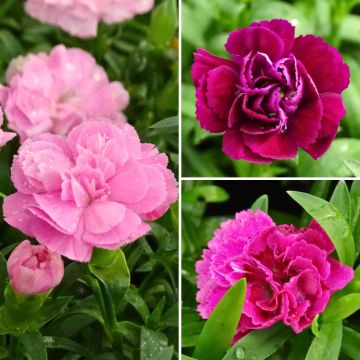

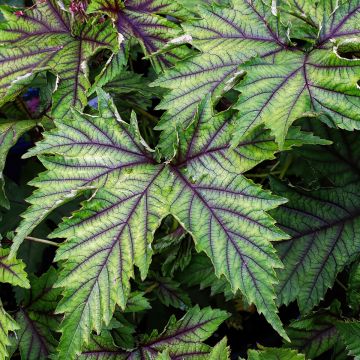

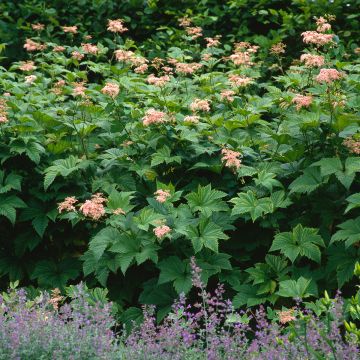
Comments